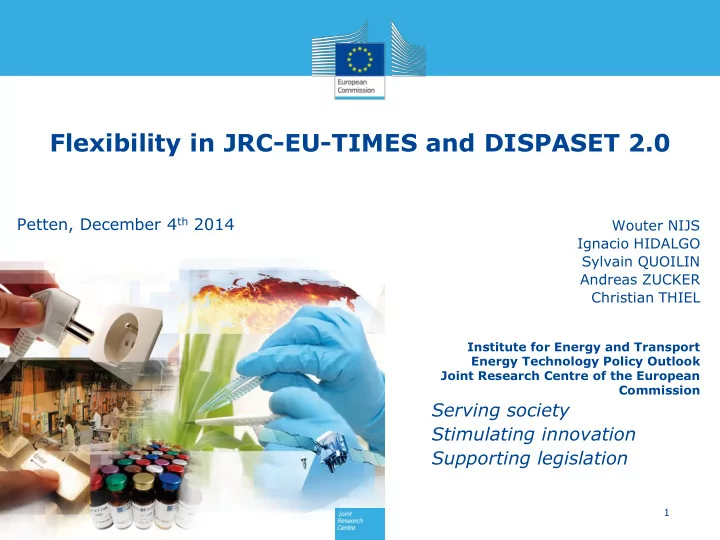

Flexibility in JRC-EU-TIMES and DISPASET 2.0 Petten, December 4 th 2014 Wouter NIJS Ignacio HIDALGO Sylvain QUOILIN Andreas ZUCKER Christian THIEL Institute for Energy and Transport Energy Technology Policy Outlook Joint Research Centre of the European Commission Serving society Stimulating innovation Supporting legislation 1
Outline JRC-EU-TIMES • • Key features and illustrative results • Improved representation of variable electricity • Ongoing work on flexibility in JRC-EU-TIMES Addressing flexibility issues in the power sector • DISPASET 2.0 • • Unit Commitment and dispatch Model • Ongoing work 2
JRC-EU-TIMES: key characteristics • Model horizon : 2005-2050 (2075) • 70 exogenous demands for energy services across 5 demand sectors (agriculture, residential, commercial, industry, and transport) • Economic drivers taken from latest EU Energy Reference Scenario (since 2014) • Explicit representation of country-to-country electricity and gas flows , incl. import / exports with non-European regions • Electricity multi-grid model (high, medium and low voltage grid), tracking demand-supply via 12 time slices (4 seasons, 3 diurnal periods), and gas across 4 seasons • Country specific differences for characterisation of the conversion and end- use technologies • Renewable potentials (onshore wind, offshore wind, geothermal, biomass, biogas, hydro) 3
JRC-EU-TIMES illustrative results 2010 2050 Electricity production Flexibility for storage and DSM
JRC-EU-TIMES coverage flexibility needs 1. Maintenance DC power flow equations are 2. Primary reserve (Frequency integrated for Central Europe control) 3. Up/down ramp rates (operational reserves) 4. Min up and down time 5. Part load efficiency 6. Start-up costs 7. Min. stable generation 8. Max. generation 9. Grid congestion 10.Energy balance, variability of RES supply Important when high penetration of variable RES 5
Improved representation of variable electricity in large energy system models 1.Force possible excess electricity from PV, wind and wave to be used by flexible demand, curtailed, stored or converted into another carrier [Gwh e ] 2.Ensure sufficient storage charging capacity [Gw e ] To ensure that the model invests not only in sufficient storage capacity in energy terms, but also in sufficient storage capacity in power terms 6
High penetration of variable RES Example summer day hours Demand OTHER (20) RES (80) TRADITIONAL
High penetration of variable RES Example summer day hours By using the production profile information Possible excess electricity Based on the maximum Maximum Power power of the combined RES of the combined variable RES systems (20) variable RES Demand systems in a OTHER (20) timeslice/region RES (60) RES (80) OTHER (40) 20% of Demand TRADITIONAL NEW 8
High penetration of variable RES EXCESS (20) Factor "2": depends on timeslice and technology Maximum Power RES of the combined (20) variable solar D systems in a timeslice/region RES 2. 𝑆𝐹𝑇 − 0.8 𝐸 = Curt. or stored (1) (60) 4 0.8 𝐸 0.2 D + = 𝑁𝑗𝑜. 𝑒𝑗𝑡𝑞𝑏𝑢𝑑ℎ𝑏𝑐𝑚𝑓 (2) 4 20% of Demand OTHER (40) 9
High penetration of variable RES Accurate Small Small representation overestimation underestimation 10
Sufficient storage charging capacity Additional constraint guarantees that the energy that is not curtailed can be EXCESS (20) "absorbed" thus forcing the OTHER (40) investment in storage power capacity (Gw e ) PV (60) 11
Ongoing work on flexibility in JRC-EU- TIMES power sector • Assess the value of energy storage and grid expansion • Test representing every single hour as well as limited number of representative days • Test stochastic modelling of intermittent renewables with two stages: investment decisions (1) and operational decisions (2) 2010 2050 Stage 1 2010 2050 -Investment decisions- Stage 2 - Operational decisions- Source: Short-term uncertainty in TIMES, ETSAP WS, Seoul, 2013, Pernille Seljom & Asgeir Tomasgard • Prepare soft linking with DISPASET 12
Addressing flexibility issues in the power sector Ideally the representation of the power sector in JRC-EU-TIMES includes all • the technical constraints within the relevant time frames. JRC-EU-TIMES Inter timeslice Fully-fledged Embedded power sector relations within Power model with high sector TIMES ! time resolution module In practice the previous approach results in a too-complex (due to • sheer size) model. Interplay between long- and short-term dynamics are taken into • account by coupling JRC-EU-TIMES to a detailed unit commitment model, while preserving some relevant constraints (work in progress). Overall boundary conditions JRC-EU-TIMES Economic and Short-term power sector Detailed unit demographic drivers constraints "Simplified" commitment Energy supply and Renewable sources power sector demand model availability module Long-term capacity Storage planning Hourly demand profiles Operational constraints or constraints on capacity expansion patterns 13
We are developing a state of the art unit commitment model DISPASET 2.0 Unit Commitment and dispatch Model Formulated as tight and compact MIP • Minimise total system costs over a daily horizon , across units, • markets and periods of fixed, variable (fuel and emissions), start-up, shut-down, transmission costs, and load shedding) Hourly demand balances (day ahead, and up and down reserves) • Bounds on power output (minimum stable generation, previous • status, installed capacity and availability factors) Ramping constraints • Minimum up and down times • Storage-related constraints (bounds on stored levels, pumping, • discharge, inter-period storage balances) NTC based market coupling • Options for emission limits, curtailment of intermittent generation and • load shedding Forthcoming JRC technical report •
Ongoing work on data Basic plant data (to be based mainly on Platts) • • Capacity, • Location, • Fuel and technology, • Others (e.g. ownership) currently not relevant Additional data • • Fuel costs IEA, TSOs, commodity exchanges, data providers • Plant operational parameters VGB Powertech , VDE, literature, … • Plant (un)availability VGB KISSY (reports) • Network data • RES data 4 December 2014 15
DISPASET 2.0 and planned extensions JRC-EU-TIMES Investment Software link Investment decisions loop between DISPASET and power prices and to JRC EU TIMES DISPASET 2.0 Unit Commitment and Hydropower Stochasticity dispatch Model Hydropower Scenario generation for constraints resulting stochastic variables and from non-power stochastic unit Data handling usage and commitment meteorology Connectivity with databases 16
Thank you! The Commission's Strategic Energy Technologies Information System Please visit the SETIS website: http://setis.ec.europa.eu 17
Recommend
More recommend